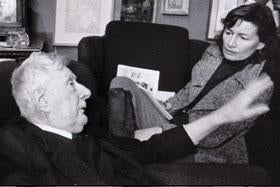
Shelley Rohde, journalist, broadcaster, author and authority on L S Lowry has died, aged 74, after a 10-year battle with cancer; typically, she told no-one when it was first diagnosed.
She was one of the most talented journalists of her era and carried the hallmarks: boundless enthusiasm for a story, genuine empathy for those she interviewed, cunning to outwit the opposition and the modesty to worry whether what she had written was good enough. She was also very good fun.
Shelley’s special talent was not only to persuade people to talk to her, but then to make their words on the printed page sound like voices on radio. As with the best stories, her own had unlikely beginnings. Born in London, she grew up in Nottinghamshire, leaving school at 16 with few qualifications, but an insatiable curiosity.
She began working on the weekly Notts Free Press in Sutton in Ashfield. From there she moved to The Star in London, before it merged with the Evening News. Soon she joined the Daily Express, then the headiest place to work in Fleet Street.
Under the editorship of Arthur Christiansen, Shelley was appointed the first woman foreign correspondent in Moscow, at the age of 21. Naturally she learned Russian. Slim, chic, young and with the influence of the Express behind her, she soon came to the attention of the then Russian premier Nikolai Bulganin and Communist party chief Nikita Khrushchev. When the pair visited Britain in the late 1950s, Shelley knew them better than most and acted as unofficial interpreter for the media pack.
Her courage while covering the Hungarian revolution is recorded in James Michener’s novel The Bridge at Andau – Shelley and other reporters were waiting at the bridge to interview refugees fleeing to Austria. They heard a baby cry; Shelley crossed the bridge, risking being shot from the Russian watchtowers, followed the cries and brought baby and family to safety.
Shelley married, but later divorced. She was immensely proud of her four children – Gavin, Christian, Daniel and Michele – all of whom have grown up to pursue successful careers in the performing arts, which gave her great pleasure; and she delighted in her grandchildren, Rowan, Billy and Solomon.
In the 1960s she left Fleet Street to freelance from a large and crumbling house in Bowdon, south of Manchester, which was remarkable for the number of talented writers, musicians, artists and other friends who pitched up unannounced for dinner or a bed for the night.
At any time one might expect to be welcomed by a drift of children, a nanny, an Alsatian dog, a dive-bombing parrot, or Shelley herself, calm amid the apparent chaos.
Eventually the pressures of an intractable bank manager persuaded her into a staff job in the Daily Mail’s Manchester office, where she soon became the senior feature writer. She covered most major stories in the North of England and Northern Ireland in the late 1960s and early 1970s and was frequently called upon by the London office; for years she quietly declined offers from Sir David English to return to Fleet Street.
It was at this time that she met a young woman from Newcastle, Linda Desramault, whose daughter had been taken from Britain by her French father. For the first time the words ‘tug-of-love’entered newspaper jargon. She and Linda made endless trips to France and Switzerland, usually in Shelley’s battered VW Beetle, until eventually Linda and her daughter were reunited – and Shelley outwitted the pack to file yet another Mail exclusive.
One of the people she interviewed was the reclusive artist L S Lowry. It was the beginning of a fascination and another turning point. After several more meetings, she huddled in a writing room in the basement of her house and researched and wrote the definitive biography of Lowry – and came as close as anyone to unravelling the mystery Ann, subject of his most-famous portraits. The book made the best sellers’ lists and was turned into a drama and a ballet.
To fund her next projects, Shelley turned to broadcasting, presenting regional news alongside Tony Wilson, hosting her own Live from Two chat shows for Granada Television, and producing ethical debates for the BBC. Somehow she also found the money to buy a wreck of a house in the hills outside Nice. Here, she wrote the
A-Z of Lowry, initially for her grand-daughter Rowan. It won the Portico Prize for Literature in 2002 and led to commissions for an A-Z of Van Gogh and another on Rembrandt.
A new exhibition opened at The Lowry in Salford on 8 December, taking a close look at three of L S Lowry’s canvases, selected by Shelley only weeks before she died. Her inspiration to the many people she came into contact with will live on in her body of work.
Email pged@pressgazette.co.uk to point out mistakes, provide story tips or send in a letter for publication on our "Letters Page" blog

